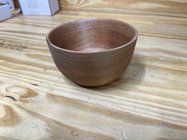After 6 months of turning pens, ornaments and small boxes, I finally decided it was time to tackle a bowl. All those months of practicing tool control seem to have paid off and I didn’t make a funnel, but it was really a challenge. Hollowing out the inside was probably the hardest part for me, it looks soo easy when folks do it in videos! Then turning off the tenon after everything was sanded and finished was just nerve wrecking! I kept thinking I was going to do some to blow up the bowl. lol
Overall it was a good learning experience and I at least have a starting point to work from now.
Things I know I need to work on:
- Tool angle on the outside of the bowl, as I got a bit of tear out when transitioning to end grain.
- Consistency in the thickness of the wall, but I’m guessing this will be become easier with practice.
Any other critiques or advice would be appreciated.
Overall it was a good learning experience and I at least have a starting point to work from now.
Things I know I need to work on:
- Tool angle on the outside of the bowl, as I got a bit of tear out when transitioning to end grain.
- Consistency in the thickness of the wall, but I’m guessing this will be become easier with practice.
Any other critiques or advice would be appreciated.

